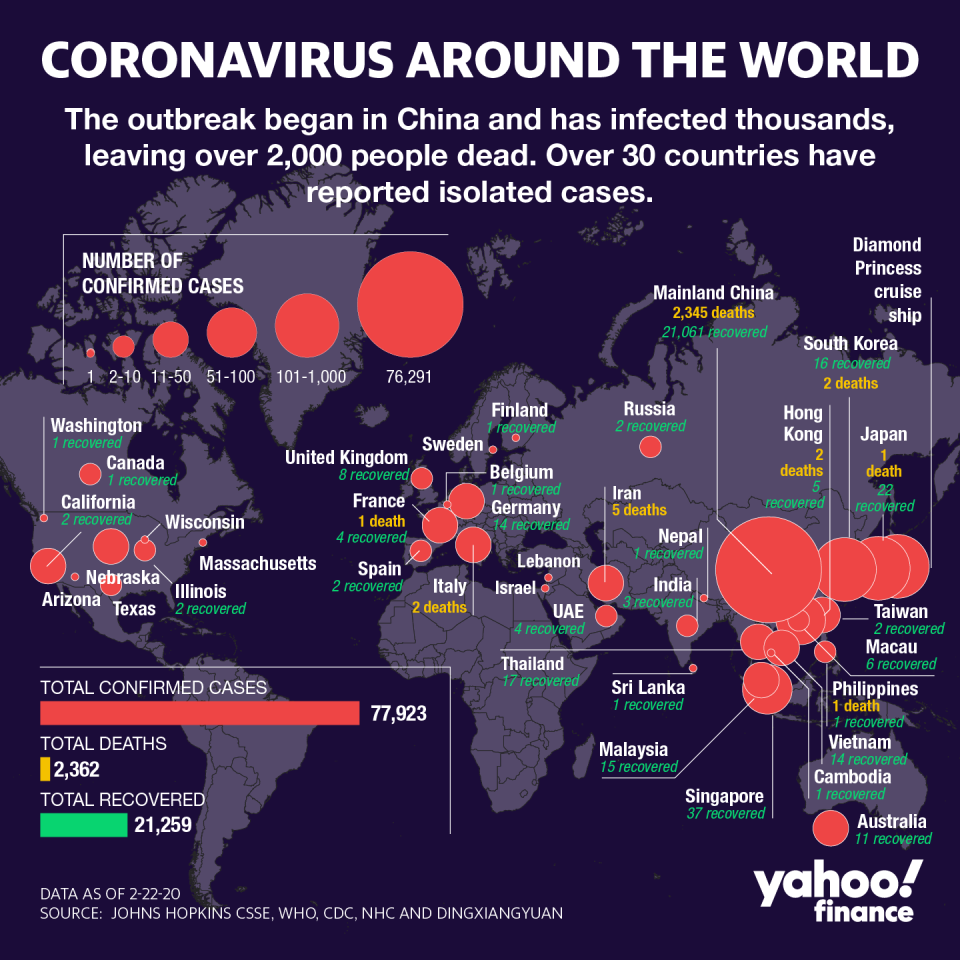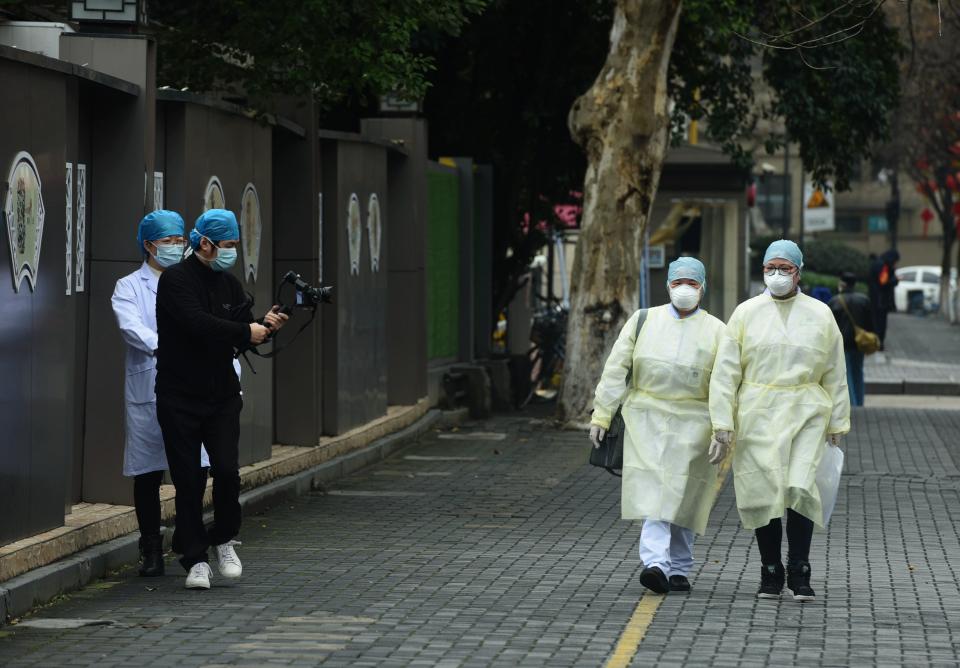Coronavirus updates: The latest from around the world
This post has been updated as of 12:00 PM E.T. on Feb. 24.
Due to the outbreak of the coronavirus, also known as COVID-19, around 79,500 people have fallen ill worldwide.
China is the epicenter of the outbreak, where the total number of cases is now 77,150 according to Chinese authorities, and the death toll has now risen to more than 2,600 globally. Most of the cases occurred in China’s Hubei Province, where the virus is believed to have originated.
Markets plunged on Monday, after the spike in the number of cases.
There are 27 deaths outside of mainland China, and major outbreaks are developing in South Korea, Iran, and Italy.
In South Korea, there are a total of 833 cases, with 300 centered around a religious group in the city of Daegu.
Iran reported 12 deaths from the virus and 61 confirmed cases. Iranian authorities closed schools and cultural and religious centers on Sunday.
In Italy, there are more than 200 cases confirmed, and five deaths.

‘China is facing an unprecedented health crisis’
There are currently 14 confirmed cases in the U.S., according to the CDC. The latest case is a Sacramento resident who recently traveled to China.
There are 21 more cases stemming from 18 passengers evacuated from the Diamond Princess cruise ship, and three who had been previously evacuated from China.
“China is facing an unprecedented health crisis,” Secretary of Health and Human Services Alex Azar told Yahoo Finance in an interview recently. “Some of this may simply be the chaos involved in quarantining over 60 million people and trying to contain a an unknown, rapidly evolving, unknown virus spreading in your country.”
Azar added that the world “must ensure that the response is transparent and vigorous, and that's something the World Health Organization has got to ensure that China is held to account for transparency and cooperation by the same standards that they would require of the United States or any other country.”
While the majority of cases are concentrated in China, other parts of the world are also being affected, giving rise to fears of a global epidemic.
The virus has taken more lives than the deadly Severe Respiratory Syndrome (SARS) in 2002, and several industries like travel and hospitality are scaling back operations in China, while others — like Boeing — sound off on concerns their difficulties operating in China.
Local businesses in the U.S. have already seen an impact: A California fisherman who supplies shellfish to China noted a huge drop in demand due to the coronavirus.
“It just killed the market,” the fisherman told CBS Los Angeles. “It’s definitely affected us. Especially in the Chinese new year. It just fell at a really bad time … the busiest two to three weeks of the year.”
How it began
The outbreak began in Wuhan, which is the capital of China’s central provide of Hubei. The virus strain was previously unknown and is speculated to have emerged late last year from illegally traded wildlife at a market in Wuhan, according to Reuters.
China on Monday issued a ban on wildlife trade and consumption until the situation calms down.
A very similar version of the coronavirus today had actually caused SARS almost a decade ago, and MERS (Middle East respiratory syndrome), The Guardian reported.
Stats from China indicate that around 2% of those infected with the new virus have died, but many of them were elderly or had prior medical conditions, Reuters reported. The mortality rate for SARS was similar when it first began, but peaked at almost 10%.

Where it’s spreading
While the outbreak has spread globally, Hubei province in China remains the epicenter. On Feb. 6, the whistleblower doctor, who had been punished for revealing the deadly respiratory virus, died.
China’s senior medical advisor said earlier this month that the number of new infections are slowing, and that the outbreak may be over in April, but during a press conference the same week, the country revised the number of new cases and the number of deaths. The number of cases has now spiked again.
In the meantime, several countries have imposed travel restrictions from Singapore (travel ban) to the U.S. (travel restrictions).
Azar added that the U.S. has also launched a surveillance system in five cities — Seattle, San Francisco, Chicago and New York — to monitor people with potential flu-like symptoms.
The uncertainty is worrying health care experts.
“I think now that it’s in more countries — even Singapore, which is really good at tracing cases, has found some cases that aren’t linked to previous known cases — it’s clear that there are probably many cases in countries where we haven’t yet found them,” Marc Lipsitch, professor of epidemiology at the Harvard T.H. Chan School of Public Health, told the Harvard Gazette earlier this week.
The World Health Organization (WHO) echoed that sentiment on Feb. 14.
“How big is the iceberg?” Dr. Mike Ryan, executive director of WHO’s emergencies program, said at a news conference. “The question is how much is happening outside what we see?”
—
Anjalee Khemlani is a reporter at Yahoo Finance. Follow her on Twitter: @AnjKhem
Aarthi Swaminathan is a reporter for Yahoo Finance. She can be reached at aarthi@yahoofinance.com. Follow her on Twitter @aarthiswami.
Read more:
Follow Yahoo Finance on Twitter, Facebook, Instagram, Flipboard, SmartNews, LinkedIn, YouTube, and reddit.


